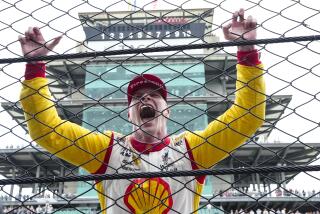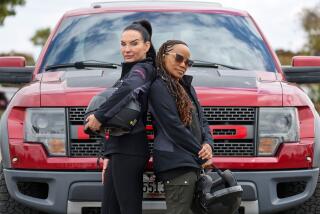Channeling Danica
Raquel Martinez didn’t see the broadcast of the Indianapolis 500. The 9-year-old was typically preoccupied with her own competition at the Moran Raceway in Beaumont.
But she was excited by Danica Patrick’s fourth-place finish, which she watched on videotape. “I just wish I could be like her, so fast,” Martinez said. “She’s really good and does whatever she can do to do well.”
Males historically have dominated all forms of motor racing, but there are indications that Patrick -- and young girls such as Martinez who are following in her footsteps -- might change the landscape.
“I’m sure there are a lot of girls bugging their parents to be like the next Danica,” said Guy Keesee, president of the Los Angeles Kart Club, one of dozens in Southern California. “In the next couple of years, I’m sure we’ll look back in the field and it will be half and half.”
Kart racing, in which children as young as 5 can compete, is the fastest-growing form of motor racing. Many Formula One, Indy car and V8 Supercar drivers developed their skills in go-karts, which range from 4-by- 4 1/2 to 6-by-6 1/2 feet and can reach speeds of more than 100 mph. Patrick, for example, was 10 when she began racing.
The International Karting Federation does not track gender, but experts estimate that at least 10% -- and perhaps as many as 25% -- of kart racers are female.
“Over the past five years we’ve probably had a 50% increase,” said Jim Hall, executive director of the Jim Hall Kart Racing School in Ventura. “Danica has had an influence. A lot more so this year, after the Indy 500. There’s been almost an instant increase of attention.”
What Martinez likes most about racing is passing boys, and the speed. She hit 73 mph at a recent race.
“When I raced before, all the boys used to pass me,” said Martinez, who notched two second-place finishes at the Cycle Sprint Grand Nationals in Santa Maria on July 4, racing in front of 20 family members and nearly 1,000 spectators. “Now I pass them and it’s fun.
“I just love all the excitement at the speed of the first turn and seeing my friends and family out there to support me.”
Martinez’s father, Raul, admires his daughter’s dedication and envisions long-term success for her in the sport. She already has a sponsor, King Taco restaurants.
“She’s really talented,” Raul said. “You give her the choice of going to a big race or going to Disneyland and, hands down, she wants to go race.”
And that also goes for Martinez’s 7-year-old sister, Casandra, who got started as a racer because she looked up to Raquel.
With two girls racing, Raul estimates the family spends about $20,000 annually for entry fees, maintenance and travel. It’s an expensive undertaking, especially when prize money is rare.
*
On a warm and windy morning at Adams Kart Track in Riverside, the air smells like gasoline and burnt rubber as Kate Carnahan expertly maneuvers her red go-kart around a track bordered by palm trees and bales of hay.
Carnahan, 19, decked out in a red-and-black plaid uniform, has been racing for close to five years. Since the age of 16, she has competed on kart racing’s senior circuit, where drivers go as fast as 110 mph and competition is no longer broken down by age and weight as it is for the younger drivers.
Carnahan was steered into go-kart racing by her father, Scott, who broke seven bones and punctured a lung while racing motorcycles.
“It’s a lot safer than motocross,” Scott said. “But kart racing doesn’t come easy. You can take things out of here and apply them to school and life.”
Kate, who races twice a month, has followed Patrick’s career since meeting her at a race in Long Beach.
“She’s my idol and I’m her biggest fan,” Carnahan said. “I look up to her so much. Looking at her, I’m like, ‘Wow, I can do it too.’ ”
Patrick, 23, led the Indianapolis 500 with as little as six laps remaining in the race, and she is among the world’s biggest sports celebrities, having made guest appearances on numerous television shows and been featured on the cover of several prominent national magazines.
But she’d never thought much about being a role model.
“I got a lot of e-mails from girls and I didn’t expect to fall into this role so quickly,” Patrick said. “Working hard has gotten me into this role and I’m not going to do anything differently.”
Earlier this month at Kansas Speedway, Patrick won her first IRL pole. Her humble nature, straightforward approach and, of course, her racing skills have earned her plenty of fans even among veterans in the industry.
“With women in driving there is still a glass ceiling of sorts,” said Doug Stokes, director of communications at Irwindale Speedway. “But when a person like Danica breaks through, it’s nut-cased the other way. I’ve never seen a rookie driver get that much exposure and be able to handle it like Danica.”
Said Troy Adams, owner of the Riverside kart track: “Girls can be girls, but when they are racing on the track they’re viewed as race car drivers. I think Danica exemplifies that.”
*
NASCAR driver Sarah Fisher, who formerly raced in the IRL, has written on her personal website, “I am not in the sport to illustrate or grow ‘the power of women.’ ”
Similarly, Patrick prefers that the focus stay on her ability as a driver as opposed to her gender.
One of Patrick’s role models, however, has made it a goal to empower more women to join the ranks of professional racers.
Lyn St. James, the second woman to race in the Indianapolis 500 and the first to be selected rookie of the year, operates an annual four-day driver development program that caters to women.
Students must submit resumes and be invited to participate in a program that devotes as much time to discussing media awareness and marketability as it does to driving.
“We’re lagging way behind other sports,” said St. James, whose program twice included Patrick. “I’m encouraged by the increase and I feel like I’ve made a dent in the process, but there’s still more work to be done.
“In today’s world, you have to have the whole package. You have to be better than good. You have to have a winning record and present yourself in a marketable fashion. If you aspire to be a professional, you have to realize the business side of the field.”
While promoting oneself is crucial, being a good racer is what opens eyes, Patrick said.
“Talent and marketability is individually based,” she said. “Just because of the hype with me doesn’t mean that all women are going to be able to run out there and get sponsors. They still have to do the job.”
Patrick’s success has been met by some criticism. Driver Robby Gordon insinuated the 100-pound Patrick had an unfair advantage because she weighs much less than the average male driver. And Formula One President Bernie Ecclestone caused a stir by saying of women racers, “You know I’ve got one of those wonderful ideas ... women should be dressed in white like all the other domestic appliances.” He later apologized.
St. James says motor racing should be genderless because “the car doesn’t know the difference.”
“Gordon’s comments aren’t totally off base from a technical standpoint,” she added. “The way he came off made it seem like he was against Danica. What Bernie said ... shows there are still some archaic views toward women in racing.”
She believes there will be more opportunities for women drivers in coming years and it is only a matter of time until they receive the respect they deserve.
“It’s already happening with Danica and it’s going to continue happening,” St. James said. “It’s something I’ve been dedicating my entire career to.”
More to Read
Go beyond the scoreboard
Get the latest on L.A.'s teams in the daily Sports Report newsletter.
You may occasionally receive promotional content from the Los Angeles Times.










